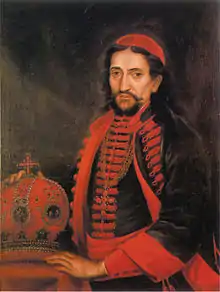Vikentije Jovanović
Vikentije Jovanović (Serbian Cyrillic: Викентије Јовановић[a]; 1689 – June 6, 1737) was the Serbian Orthodox Metropolitan of Belgrade and Karlovci from 1731 to 1737, as Vikentije II. During his diplomatic mission in Vienna in 1734, he was given permission by Emperor Charles VI to establish a hussar regiment constituted solely of Serbs and Croats. It was officially named Illyrian-Rascian regiment and inaugurated on June 16, 1735, in a grand ceremony officiated by Vikentije. The ceremony took place outside Budim where the banners which were used symbolized his importance in the Austrian Empire, but also the dual symbolism of East and West; dual coats of arms on their spears, two languages in their inscriptions (Church Slavonic and Latin), and the use of Eastern iconography and Western emblematic imagery. Vikentije's hussars went on to fight in the Austro-Russian–Turkish War (1735-1739).[1]
Metropolitan of Belgrade and Karlovci Vikentije II | |
|---|---|
 Oil painting. | |
| Church | Serbian Orthodox Church |
| Province | Military Frontier, Austrian Empire |
| Metropolis | Sremski Karlovci |
| Installed | 1731 |
| Term ended | 1737 |
| Predecessor | Mojsije Petrović |
| Successor | Arsenije IV |
| Personal details | |
| Born | 1689 Szentendre, Ottoman Hungary (modern Hungary) |
| Died | June 6, 1737 (aged 47-48) Belgrade, Kingdom of Serbia, Habsburg Monarchy (modern Serbia) |
| Denomination | Eastern Orthodox |
Biography
Jovanović was born in Szentendre in 1689. As a young man he took monastic vows at Rakovac monastery. He was among the first Serb graduates of the National University of Kyiv-Mohyla Academy; others were Gavril Stefanović Venclović, Simeon Končarević, Visarion Pavlović, Dionisije Novaković, Jovan Rajić, Gerasim Zelić, Arsenije Stojkov Tarbuk, and in the 19th century Nikodim Milaš, Stevan Dimitrijević, and Svetolik Ranković to name but a few.
He played a pivotal role in uniting the Metropolitanate of Belgrade with the Metropolitanate of Karlovci at the Assembly of Bishops (Sabor) in 1726. At the end of the Sabor, he was elected Bishop of Arad with Jenopolje and Veliki Varadin. On March 22, 1731, he was unanimously elevated Archbishop and Metropolitan of the Metropolitanate of Karlovci by the Assembly of Bishops of the Serbian Orthodox Church.
The history of the Metropolitanate of Karlovci, located in northern Serbia in the region of Vojvodina, is intimately connected to the large exodus of Serbs fleeing Ottoman persecution that followed after the Great Turkish War of 1683-1699 and the Austro-Turkish War of 1716–1718. It was in 1690 that Patriarch Arsenije III Čarnojević (1674-1706) led almost 40,000 people over the Danube River and into Vojvodina, then under Austro-Hungarian rule. A significant number of Serbs were already living there since the very beginning of the Nemanjić dynasty, if not before, and the continuity allowed the refugee to feel at home.
With renewed Turkish oppression in Ottoman Serbia, the Serbs in the Habsburg Empire found themselves also facing new challenges. This task was made an especially difficult living with predominantly Roman Catholic Austrian and Hungarian authorities and confronting daily pressure toward union with Rome. Realizing that the preservation of their spiritual identity demanded higher education, Vikentije II turned to Russia for help, like his predecessor Metropolitan Mojsije Petrović. At the time basic conditions for education, such as high schools, adequately trained teachers and books, were lacking. Orthodox Russia, sharing a similar language and alphabet with Serbs, was seen as an ideal ally. Soon, promising students were sent to Kiev, to study theology, philosophy and the sciences at the well-known Kievan Academy. By the eighteenth century, this trend would result in the systematization of education and the opening of the first Slavonic-Latin schools. Maxim Suvarov, sent by the Synod of the Russian Orthodox Church, became the first Russian teacher there. In 1731, Metropolitan Vikentije II opened gymnasia (high schools) in Belgrade, Osijek, Dalj and Sremski Karlovci. In Karlovci he put another Russian educator, Emanuel Kozačinski, in charge.
Annotations
- ^ His name is also spelt as Vićentije (Serbian Cyrillic: Вићентије Јовановић).
References
- Вуковић 1996, pp. 70-73.
Sources
- Bataković, Dušan T., ed. (2005). Histoire du peuple serbe [History of the Serbian People] (in French). Lausanne: L’Age d’Homme. ISBN 9782825119587.CS1 maint: ref=harv (link)
- Ćirković, Sima (2004). The Serbs. Malden: Blackwell Publishing. ISBN 9781405142915.CS1 maint: ref=harv (link)
- Đorđević, Miloš Z. (2010). "A Background to Serbian Culture and Education in the First Half of the 18th Century according to Serbian Historiographical Sources". Empires and Peninsulas: Southeastern Europe between Karlowitz and the Peace of Adrianople, 1699–1829. Berlin: LIT Verlag. pp. 125–131. ISBN 9783643106117.CS1 maint: ref=harv (link)
- Pavlovich, Paul (1989). The History of the Serbian Orthodox Church. Serbian Heritage Books. ISBN 9780969133124.CS1 maint: ref=harv (link)
- Todorović, J. 2002, "The banners of the Illyrian-Rascian regiment in the context of ephemeral spectacle", Nasleđe, no. 4, pp. 79-87.
- Todorović, Jelena (2006). An Orthodox Festival Book in the Habsburg Empire: Zaharija Orfelin's Festive Greeting to Mojsej Putnik (1757). Aldershot: Ashgate Publishing. ISBN 9780754656111.CS1 maint: ref=harv (link)
- Вуковић, Сава (1996). Српски јерарси од деветог до двадесетог века (Serbian Hierarchs from the 9th to the 20th Century). Београд: Евро.CS1 maint: ref=harv (link)
| Eastern Orthodox Church titles | ||
|---|---|---|
| Preceded by Mojsije |
Metropolitan of Belgrade and Karlovci 1732–1737 |
Succeeded by Arsenije IV |